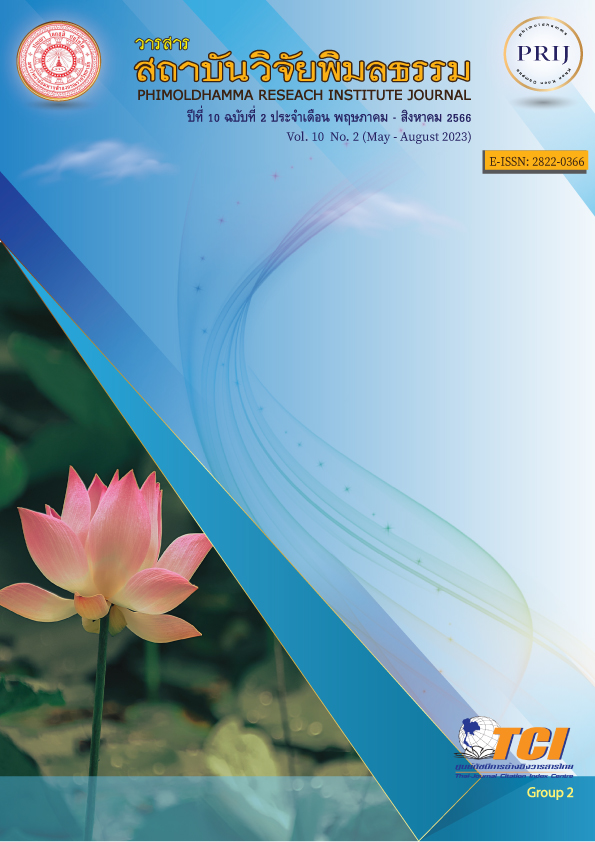The Characteristics of Educational Institution Administrators in 21ST Century According to the Four Bala of Educational Institutions under the Dhammikajana Foundation for the Blind in Thailand under the Royal Patronage of His Majesty the King
Keywords:
Characteristic, Administrator, The 21st Century, The Four BalaAbstract
The objectives of this research were: 1) to study the characteristics of educational institution administrators in the 21st century according to the Four Bala of educational institutions under the Dhammikajana Foundation for the Blind in Thailand under the Royal Patronage of His Majesty the King; 2) to study the development guidelines for educational institution administrators' characteristics in the 21st century, according to the Four Bala of educational institutions under the Dhammikajana Foundation for the Blind in Thailand under the Royal Patronage of His Majesty the King. This study was carried out by means of mixed-method research. The sample group selected by using Krejcie and Morgan’s method at the 95% confidence level and purposive sampling. Statistics used in data analysis were: frequency, percentage, mean, and standard deviation.
The research results were as follows:
1. The characteristics of educational institution administrators in the 21st century according to the Four Bala in overall and aspect perspectives, were statistically rated at a high level of practice. The most practical aspect was being a good role model, and the aspect that had the lowest level of practice was being creative and entrepreneurial.
2. The development guidelines for educational institution administrators' characteristics in the 21st century, according to the Four Bala were that in terms of vision, theoretical knowledge, skills, roles and responsibilities, experience in modern educational administration should be developed. In terms of academic, communication, and technology competence, knowledge and competence to pass on to subordinates with potential should be created. In the aspect of being an innovator and an entrepreneur, administrators should be creative, think outside the box, and, create new things. In the aspect of positive motivators, the administrators should have the ability to convince, be good listeners, and have good suggestions for personnel. In terms of being a good model, they should be an example of the development for subordinates to learn and implement. Regarding the construction of a learning community, they should encourage the use of learning methods together to determine the solutions to the problem.
References
กุลจิรา รักษนคร. (2563). คุณลักษณะผู้บริหารสถานศึกษาในศตวรรษที่ 21. Journal of Modern Learning Development, 5(3), 328-344.
ชยาภรณ์ จันโท และหิรัญ ประสารการ. (2560). การศึกษาคุณลักษณะของผู้บริหารสถานศึกษาที่ส่งผลต่อการจัดการศึกษาในศตวรรษที่ 21 ของสถานศึกษา สังกัดสำนักงานเขตพื้นที่การศึกษาประถมศึกษาพังงา. วารสารวิชาการมหาวิทยาลัยราชภัฏภูเก็ต, 13(1), 304-320.
ชีวสาธน์ กิ่งแก้ว. (2564). คุณลักษณะผู้บริหารสถานศึกษาที่ส่งผลต่อขวัญในการปฏิบัติงานของครู สังกัดสำนักงานเขตพื้นที่การศึกษาประถมศึกษาฉะเชิงเทรา เขต 1. เข้าถึงได้จาก http://thesis.rru.ac.th/frontend/view/678#
ธงชัย เจนโกศล. (2557). คุณลักษณะของผู้บริหารสถานศึกษามืออาชีพตามความคิดเห็นของครูผู้สอนในโรงเรียนมัธยมศึกษาจังหวัดกาญจนบุรี สังกัดสำนักงานเขตพื้นที่การศึกษามัธยมศึกษา เขต 8. (การค้นคว้าอิสระครุศาสตรมหาบัณฑิต). กาญจนบุรี: มหาวิทยาลัยราชภัฏกาญจนบุรี.
พรทิพย์ สุขเอียด. (2562). คุณลักษณะที่พึงประสงค์ของผู้บริหารตามทัศนะของครู สังกัดสำนักงานเขตพื้นที่การศึกษาประถมศึกษาสงขลา เขต 3. (สารนิพนธ์ศึกษาศาสตรมหาบัณฑิต). สงขลา: มหาวิทยาลัยหาดใหญ่.
พระธรรมโกศาจารย์ (ประยูร ธมฺมจิตฺโต). (2549). พุทธวิธีการบริหาร. กรุงเทพฯ: มหาจุฬาลงกรณราชวิทยาลัย.
พระพรหมคุณาภรณ์ (ป.อ. ปยุตฺโต). (2546). ธรรมนูญชีวิตพุทธจริยธรรมเพื่อชีวิตที่ดีงาม. (พิมพ์ครั้งที่ 57). กรุงเทพฯ: สำนักงานพระพุทธศาสนาแห่งชาติ.
พระราชบัญญัติการจัดการศึกษาสำหรับคนพิการ พ.ศ. 2551. (2551, 5 กุมภาพันธ์). ราชกิจจานุเบกษา. เล่ม 125 ตอนที่ 28ก, หน้า 1-13.
มหาจุฬาลงกรณราชวิทยาลัย. (2539). พระไตรปิฎกภาษาไทย ฉบับมหาจุฬาลงกรณราชวิทยาลัย. กรุงเทพฯ: มหาจุฬาลงกรณราชวิทยาลัย.
สมหมาย อ่ำดอนกลอย. (2556). บทบาทผู้บริหารสถานศึกษาในศตวรรษที่ 21. วารสารบัณฑิตศึกษา มหาวิทยาลัยราชภัฏพิบูลสงคราม, 7(1), 1-7.
สัมฤทธิ์ กางเพ็ง และคณะ. (2565). การวิจัยแบบผสมผสานวิธี: กระบวนทัศน์การวิจัยในศตวรรษที่ 21. วารสารครุศาสตร์ปัญญา, 1(3), 66-85.
สาคร มหาหิงค์ และคณะ. (2565). คุณลักษณะผู้บริหารสถานศึกษายุคดิจิทัล. วารสารครุศาสตร์ปัญญา, 1(4), 62-75.
สำนักงานคณะกรรมการพัฒนาการเศรษฐกิจและสังคมแห่งชาติ. (2560). แผนพัฒนาเศรษฐกิจและสังคม แห่งชาติ ฉบับที่ 12 พ.ศ. 2560-2564. กรุงเทพฯ: สำนักงานคณะกรรมการพัฒนาการเศรษฐกิจและสังคมแห่งชาติ.
สุรีพร พันยุโดด. (2560). คุณลักษณะผู้นำของผู้บริหารสถานศึกษาที่ส่งผลต่อการจัดการความรู้ในสถานศึกษา สังกัดสำนักงานเขตพื้นที่การศึกษาประถมศึกษาราชบุรี เขต 2. Journal of Thai Interdisciplinary Research, 11(4), 34-40.
Aydin, B. (2012). Transformational Leadership Behaviors of School Principals: A Qualitative Research Based on Teachers Perceptions. International Online Journal of Educational Sciences, 4(3), 581-591.
Daft, R. L. (2022). Management. (14th ed). Boston: Cengage Learning.
Ibrahim, A. T. (2015). Strategy Types and Small Firms' Performance an Empirical Investigation. Journal of Small Business Strategy, 4(1), 13-22.
Krejcie, R. V., & Morgan, D. W. (1970). Determining Sample Size for Research Activities. Educational and Psychological Measurement, 30(3), 607-610.
Remer. (2010). Words of Wisdom: Keys to Success in the scripps National spelling Bee by Scott. Retrieved from http://kayleadershipacademy.com/2013/04/effectiveLeadership-skillsclear-vision/Skills_for_21st _century.hrml
Toastmaster. (2013). Must have leadership skills for the 21st century. Retrieved from http://westsidetoastmasters.com/articleReference/musthave leadership
Waston, S. H. (2000). Leadership requirements in the 21th century: The perceptions of Canadian private sector leaders. Retrieved from https://digitalcommons.andrews.edu/dissertations/






